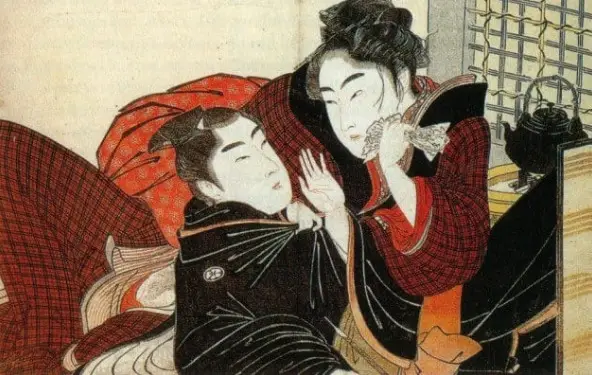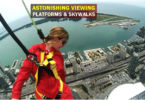10.What Did “Kamikaze” Mean Back Then?
First, it helps to know the actual Japanese meaning of the word. Literally, as when reading, kamikaze would be read simply as “god-wind”, but more commonly it denotes the “divine wind”, which was the light in which the Japanese saw the kamikaze soldier during WWII. The Japanese concept of the “divine wind” dates back in their culture to the Middle Ages, when twice, invading fleets of Mongolian warships were devastated en route by typhoons, both times preventing the Japanese from shedding a drop of blood on your defense. They called these miraculous events “divine wind” and were taught to all school-age children in Japan, and in WWII, their hopes were that these kamikazes would be their new divine wind, snatching them out of the jaws of God again. the defeat. However, in the West, especially for the allied military, the kamikazes were simply pilots or suicide soldiers of the Imperial Japanese Empire, who brutally attacked the allied forces from the air, land and sea, in the most costly, longest fight. and most horrible of the entire war, with total disregard for their own lives. It is interesting to note that a “divine wind”, this one called Typhoon Cobra, managed to devastate the Allied Pacific Fleet, then commanded by Admiral William ‘Bull’ Halsey, on December 14, 1944, en route to attack the Japanese. . Nicknamed “Typhoon Halsey”, this tropical maelstrom claimed the lives of 790 sailors and sank at least two destroyers in the Philippine Sea, east of Luzon.
9.The Ancient Japanese Samurai And Their Bushido Code

The ancient samurai ideology, and its Bushido Code, was condensed into “Hagakure”, which was a collection of 18th century samurai anecdotes and axioms that literally began with the phrase “The way of the samurai lies in death …”, and thus it was clearly intended to reinforce the belief that a soldier had to be ready to die for his emperor at all costs. This would soon become the central philosophy of the Japanese soldier who had already adopted the samurai ideology, thus later adopting the Bushido philosophy reprinted in Hagakure as well. Although it was never reprinted in its entirety before the 1930s, that would change with the war when a commentary, praising the logic of Hagakure’s message, was published in 1940 and given to every Japanese soldier to take with them into battle. . Today, military historians are not quite sure whether the Japanese soldier’s failure to surrender was due to his belief in samurai traditions and the Bushido Code, fear of being executed by his own side out of cowardice, or even by “murderous” Americans. who told them that he would also kill them if they were captured by them. Whatever the case, the ancient samurai ideology and the Bushido Code, along with the message they carried with them in Hagakure, obviously influenced the Japanese WWII soldier in a deadly way for everyone involved.
8.The Precursors To Kamikaze Strikes—Banzai Charges, Suicide Bombers, And Suicide Pilots
Long before 1944, when the kamikazes began attacking the allied forces in earnest, the Japanese had already been fighting suicide tactics similar to the kamikazes. In Europe, where more than five million German soldiers had surrendered to Allied forces, in the Pacific, that number was less than five percent, or not many. Although the allies were unprepared for these heinous suicide attacks, they were well aware of the suicidal tendencies of their enemies in battle. For example, during the Pacific Theater’s “island hopping” campaigns, the front “Banzai!” Charges against entrenched Allied positions by waves of Japanese soldiers, and attacks by individual suicide bombers with portfolio charges sent to take out tanks, were not unheard of, but the Allies then viewed them as acts of desperation born out of desperate situation. However, in hindsight, the Allies may have known that their enemies were potentially suicidal, as there was a deadly kamikaze-like attack in 1941 that very few have heard of, in a battle far from Pearl Harbor. some also may not have heard of them. This battle occurred when the U.S.S. Curtiss was hit just under the bridge by a Japanese suicide pilot while engaged with Japanese fighter jets and a midget submarine off the north coast of Hawaii on December 7, 1941. The incident, although isolated and not sanctioned by the Japanese navy , caused 54 casualties aboard the American warship. Note that this type of unsolicited attack by the Japanese was called “kesshi”, referring to when a person makes a decision to “dare to die”. (“Banzai” is a Japanese battle cry that means “May you have ten thousand years of long life!”)
7.Japanese Prime Minister Orders Tokkō Missions
As early as mid-1943, Japanese top brass knew that bombing targets with heavy combat aircraft was inaccurate and extremely expensive. They also knew that due to failures, American bombers had to drop three or four times as many bombs as necessary to destroy a planned target, and they did not have those resources to call on Allied forces. So they had to improvise, and they improvised they did, and they came up with the concept of “one plane, one ship” with the pilot and the plane together acting like a human-guided bomb. But the concept needed to be tested first, and so on. On October 14, 1944, a Japanese rear admiral did just that. He got on his plane, took off, found the closest Allied ship, and rammed it. That allied ship was the American aircraft carrier U.S.S. Franklin, and the Divine Wind — or Kamikaze — was reborn. And then the Allies would soon learn more than anyone that the concept of “one plane, one ship” would not last for their enemy, as the kamikaze fighter jets would eventually attack the Allies en masse. The new divine wind really began to blow when Japanese Rear Admiral Kamito Kuroshime first proposed voluntary suicide attacks in July 1943 called “tokkō”, or Divine Wind Special Attack Units, which were initially repulsed by the rest of the imperial command. . But as the Japanese losses mounted, as they had in the battles of Coral Sea, Midway, and Guadalcanal, they were forced to rethink the idea. Tokkō was officially militarized when Japanese Prime Minister Hideki Tojō gave the order to begin forming ‘special suicide missions’. These missions would use up much of the inventory in the Japanese arsenal, with a few more added, but warplanes and their expendable pilots were the primary weapon of choice for the kamikazes. Zeros, Oscars, Waltzes, Kates, even Betty bombers and other vessels of many types were used in the kamikaze suicide attacks. Documents captured after the war revealed that the pilots had to be volunteers, so Emperor Hirohito had a plausible denial and could not be charged. him with war crimes, as he could claim that he knew nothing of Tokkō’s tactics and strategies.
6.Bomb-Laden Midget-Submarines Called Kiaryu (Sea Dragon) and Koryo (Japanese Meaning Unknown)
5.“Scubacidal Maniacs” Called Fukuryu (Crouching Dragon)
Imagine, if you will, a 1940s suicidal frogman, or “fukuryu,” silently gliding into the murky sea. He carries a huge anti-consignment mine filled with high explosives and a very long pole to hold it up. He swims stealthily underneath a giant steel ship, invisible and plunged into inky darkness, where he plans to detonate his deadly device; standing at the bottom with the extended upward on his pole, to sink the steel giant looming ominously above him. This is another potential horror story that the Allies would have grappled with had they needed to invade Japan by conventional means as they had originally planned. After the end of the war, Japanese records indicated that they had 1,200 Fukuryu suicide frogmen trained, but that they had no mines for them when they surrendered. This lack of ordinance is believed to be because its commanders did not anticipate the atomic bomb attacks, the rapid destruction of two of its major cities, and the subsequent surrender aboard the US Missouri. Military historians believe these Zealot early suicide divers would have been armed had the Allies invaded, and could have caused considerable casualties and damage to anchored ships.
4.Human-Guided, Cruise Missiles Called The Ohka (Cherry Blossom)
The kamikazes actually flew a bomb-laden, jet-guided, human-guided cruise missile called the Ohka. The Japanese word means “cherry blossom”, but they sure weren’t pretty. To the allied military they were “bakas”, which is Japanese for “fool” (referring to their pilots, who thought they were “idiots”). They were literally flying human bombs with a rudimentary fighter plane built around them, and there was barely enough room for a pilot to sit down and take him to the closest friendly ship he could find. They were powered by three powerful rocket engines and came in various models. They carried 550 pounds (250 kg) of high-powered explosives and could fly as fast as 650 mph (1046 kph). Most of the men on the boats they were targeting could barely see them, much less shoot them. They were launched from under the bellies of the Betty bombers and came just above the waterline, so the ohkas were hard enough to see as they were, but at these speeds they were almost impossible to hit with a cannon or a machine gun, especially at such low angle for ship’s gunners. Fortunately for the Allies, the Betty motherships were large and slow and easily shot down by Allied fighters long before becoming a danger to Allied warships, although a “baka” was reported to have sunk an Allied warship.
3.Human-Guided, Anti-Aircraft Missiles Called The Taiatari (Body Strike)
In 1944, when the American B-29 Superfortress began to hit Japan from the air, the Japanese air forces were in tatters, but what they still had to work with was the “taiatari”, which was a single Ki-44. -seat, fighter plane “Tojo”. It was the most feared and heavily armed Japanese fighter of the Allied bomber crews, sporting two very dangerous 40mm guns. The taiatari may have been conceived with the German’s Sonderkommando Elbe in mind, which was a German fighter stripped of much of its weight, except for 60 rounds of ammunition to gain altitude in order to get high enough to physically strike at Allied bombers in the air. . The Japanese had the same in mind when they modified the Ki-44 Tojō in the same way to attack the B-29s over Japan. The idea was to get close, fire as many rounds as accurately as possible, and then ram into the closest bomber they could find! Given that the Japanese air force was so decimated at this point in the war, this tactic can only be seen as a last-ditch effort and thus obviously had little to no effect on the Allied bombing campaign of the Japanese home islands.
2.Human-Guided Torpedoes Called The Kaiten (Return to Heaven)
Now imagine that you are a Japanese “kaiten” pilot. It’s a beautiful day in the South Pacific in August 1944, as you climb into your slim and sinister ship, a Type 93 “Long Lance” torpedo with a cockpit carved into the hull big enough to be squeezed. within. Your mission: first, get on the torpedo, then find the closest friendly ship and direct the giant bomb at it. “Piece of cake, right Joe?” You may find the concept of anything but “simple”, but for the Japanese kaitens were one of the most effective suicide weapons of WWII, second only to their kamikaze fighter jets in effectiveness. The Japanese Type 93 Long Lance was a very reliable and powerful, oxygen-propelled torpedo, which was 2 feet (61 cm) in diameter, just 30 feet long (9 m), weighed 6 tons (2721 kg) and carried a warhead of 1,080 pounds (490 kg), with an effective range of 24,000 yards (22,000 m), at 59 mph (96 kph), around 52 knots, or as fast as a respectable family speedboat. After a rigorous training period that involved a lot of dangerous diving (in which 15 trainees died) and maneuvering around an underwater obstacle course, these 17-28 year old suicide pilots were, later in the war, literally locked up inside his coffin. so that they could not escape his horrible disappearance even if they wanted to. But then, in later models, the pilots were provided with a self-destruct mechanism, in case their mission “failed.” Thank goodness for the little favors, right?
1.Human-Guided, Bomb-Laden, Speedboats Called The Shin’yōs (Ocean Shaker)
Both the Japanese Navy and Army used suicide speedboats (officially called motorboats back then) and had several different versions, but with the same result in mind: destruction. The naval version of these human-guided suicide speedboat bombs had a crew of one (imagine that) and could reach speeds close to 34 mph (55 kph), or 30 knots. They were equipped with a 660-pound (299 kg) load installed in the bow, which was connected to blow with the flick of a switch if the pilot deemed it necessary. These ships also came equipped with two rocket launchers loaded with anti-ship ordinance for an additional “hit”. The army version was similar, and it was called Maru-ni, but it was not a suicide weapon per se. The idea of the army was to run close to an allied ship, unload one of its two depth charges, then turn around and run, hoping to escape the returning fire that is going to rain down on you and / or the wave of the explosion. running towards you from behind, on the way out of danger. Having two depth charges on board gives you twice the chance of succeeding in this harrowing activity. Apparently, there were reports of crew members returning alive, but this was extremely dangerous at best, and most would think it was suicidal to even consider it as more than just a suicide mission.
+.The Biggest And Baddest Battleship In Naval History Was Used As A Kamikaze
This warship was the pride and joy of both the Japanese Navy and its people, and was named accordingly. The Yamato was named after her from the ancient state of Yamato, which was the name of the first Japanese empire in its long and historical history. This battle tank was one of only two on the planet that once sported a set of nine 18-inch Type 94 naval rifles. These hulking, exquisitely designed main guns had an effective range of 26 miles (74,029 km) and fired a 3,220 pound (1,460 kg) projectile. All nine were quite capable of loading and firing a projectile as heavy as a large car as far as the eye can see and successfully hit a target, making the Yamato a very formidable weapon, if used correctly, if not, then you end up with it. April 7, 1945 and the results of Operation Ten-Go. Before this, the Japanese were so reluctant to use this ship, that she only fired angrily at her enemies once during the entire war, and this was before Operation Ten-Go. most powerful battleships to ever float, and the Musashi had already been lost in the Battle of Leyte Gulf in the Philippines more than a year earlier. At 80,248 tons (36,476 kg) at full load, the Yamato class of battleships featured nine 18-inch (460 mm) Type 94 naval rifles, which were the largest ever launched to sea. Only two of the three ships in the class had these huge main naval guns, and one of them was at the bottom. Before Operation Ten-Go, the last Japanese offensive naval operation of World War II, but on that day in April 1945, she would be sent with her crew to be sacrificed in a kamikaze attack against the already-existing Allied forces. fighting in Okinawa. in complete disaster when the Japanese force was attacked by Allied carrier fighters long before they were in position to attack. In a strong show of Allied air superiority, in the resulting deluge, Yamato, along with at least 3,700 of her crew, were lost at sea when her powder magazine exploded. Several other Japanese ships were sunk and many others suffered damage. Sailors drowned, planes were destroyed, and their precious pilots were lost, along with Japan’s ability to fight offensive war again in WWII.





